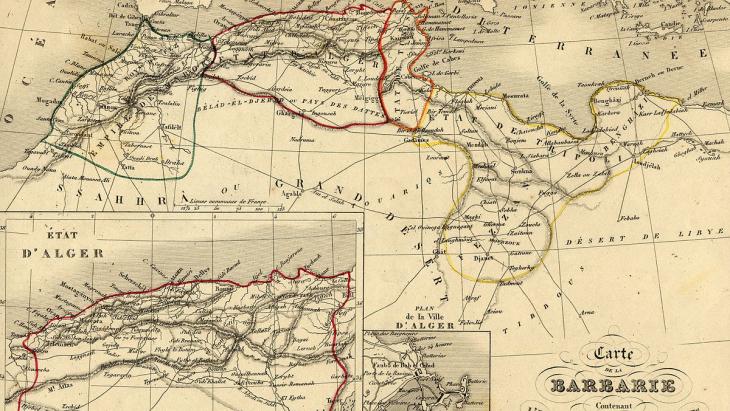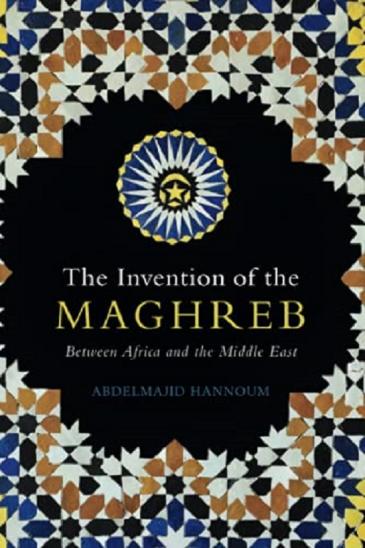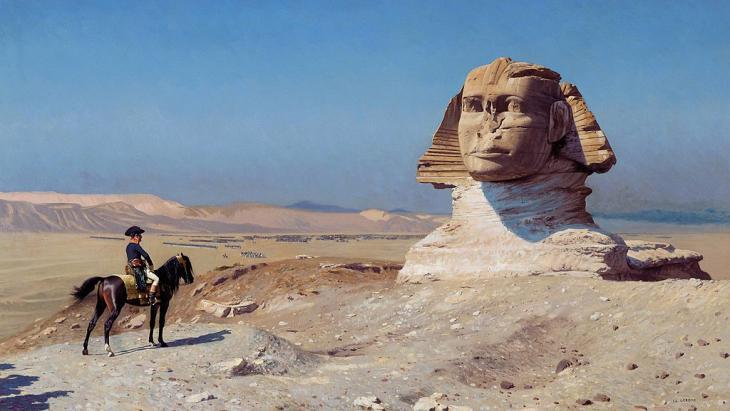Was the Arab Maghreb a French invention?

In his book The Invention of the Maghreb: between Africa and the Middle East, Abdelmajid Hannoum, professor of anthropology at the University of Kansas, chronicles the processes by which the French colonies in North Africa were formed into a single geographical and cultural entity, separate from its surroundings. It is in this context that he presents a history of the term "the Maghreb", which was favoured by strategists in the French colonial administration.
He chronicles it as a term and as an epistemological structure, as well as how this concept has reshaped so many fields of knowledge. With his examination of the history and myths of the region from post-colonial perspectives, Hannoum completes the process he began with his earlier academic works in this same field, most notable of which are: Colonial Histories and Postcolonial Memories: The Legend of the Priestess, a North African Heroine (2001) and Violent Modernity: France in Algeria (2010).
Published in English by the University of Cambridge in 2021, The Invention of the Maghreb joins a series that can be figuratively called "invention studies", foremost of which is The Invention of Tradition by Eric Hobsbawm and Terence Ranger. Also in this group is the reference work The Invention of Africa by the Congolese VY Mudimbe, and Todd Shepard's The Invention of Decolonization: The Algerian War and the Remaking of France.
In the same fashion, Hannoum points out that the inventions of colonial modernity, i.e. that historic moment when modernity arrived alongside colonial rule in the colonized world, did not create structures out of nothing. Rather, they fashioned working systems out of existing elements, both historical and local. In other words, they re-structured the old using the tools of modern knowledge and the agencies of military force to serve and to justify colonial ends.
Re-thinking the origins of everyday terminology

The book prompts us to review basic terminology, including names that we use almost every day as if they are definitive by virtue of geography, history and culture, such as "the Arab Maghreb", "North Africa", "the Middle East" and "sub-Saharan Africa". Was the Arab Maghreb nothing more than a French invention?
Hannoum takes us back to Arabic writings about the region, which refer to a "Middle Maghreb", a "Far Maghreb" (or Maghreb al-Aqsa) and "Ifriqiyya" (present-day Tunisia). It is also a Maghreb (or West) in counterpoint to the Mashreq (or East), but it is a Maghreb that can include parts of Libya, and at times parts of West Africa and Southern Europe as in the period of al-Andalus. In the later Ottoman era, the Maghreb is not portrayed as a single territory, but rather with semi-autonomous entities in Tunisia and Algeria. In Western writings in the seventeenth century, the region was called "Barbary" and had separate kingdoms, starting with the Kingdom of Tripoli in the east and stretching to the Kingdom of Morocco and the Atlantic coast.
"In the Bonapartist tradition... science is a tool for dominion and occupation," writes Hannoum, who goes on to say that the invention of the Maghreb finds its roots in the French campaign in Egypt. Accompanied by the scientific delegation entrusted with the encyclopaedic work Description de l'Égypte, the soldier was no longer there just to fight; he was obliged to draw maps, participate in archaeological excavations and anthropological research, as well as to carry out the tasks of linguist and painter of urban and rural scenes. It is no surprise that the pioneers of the colonial campaign against Algeria and the founders of the concept of the "Maghreb" were among those who had served in Bonaparte's campaign against Egypt.
The importance of maps
From a geographical perspective, the book presents maps as a record of the forces that shaped them; for all their seeming simplicity, the cartographical data carries unique authority. Thus, Hannoum is preoccupied with the way in which maps were produced culturally, since their particulars reveal a narrative about the place, from a local perspective.
To this end, he draws on maps to show how the notion of the region fared, from the Roman era to the maps of the Arab cartographer Muhammad al-Idrisi (1099–1166) and all the way to the European maps of the seventeenth century. The latter divide the world into domains of natural ownership i.e. lands owned by feudal monarchs and lands where chaos and barbarism reign. In the Bonapartist imagination and according to ancient Greek tradition, Egypt falls in Asia, or it is in neither Africa nor Asia, or perhaps it is in both. Either way, Egypt is portrayed as not being part of Africa, especially after it fell under British hegemony. The neo-colonial maps of North Africa took after the Roman maps. Continuity was a key element of colonial ideology. The Latin names were translated into French. Maps of the region show it as an extension of France, as are the lands it describes. At the same time, Latin and Arabic writings were translated using nineteenth-century terminology.
The separation of Egypt from the Arab Maghreb was justified by an arbitrary separation between the Egyptian Sahara and the Maghrebi Sahara. As for Libya, which lies in the middle and was under Italian rule, it was either separated from Morocco or divided into three sectors, one belonging to Egypt, another to Morocco and the third to the Sahara or sub-Saharan Africa.

"White Africa" and "Black Africa"
The French geographer Émile-Félix Gauthier laid the first racial foundations for the geography of a "white Africa". Whiteness was no longer exclusively European, and since Africa was black by definition, "Greater Maghreb" became a separate entity. The Greater Sahara was depicted as a space for crossbreeding between the white race and black Africa. Meanwhile, the Tuareg tribes played the role of keeping the two races apart. Later on, the Moroccan Sahara became annexed to French North Africa. Alongside this, the Middle East was invented on the other side of the map, separate from "Greater Maghreb", which was in turn separate from Africa.
"Archaeology doesn't speak for itself, but rather it requires archaeologists to interpret it, so that voiceless objects can be transformed into symbols of invented traditions," writes Hannoum. In light of Hannoum's definition of history as a colonialist field of knowledge aimed at understanding the past in order to control the present, his book traces the roles played by French archaeology to justify colonialism and to define the region as one distinct from its surroundings. Since the excavations in Carthage by the White Fathers (Les Pères Blancs or Missionaries of Africa), the colonial administration sought to unearth Christian history of the region. Roman archaeological sites in particular played a major role in defining this Christian history in the colonial imagination.
Egypt and Iraq belonged to the ancient world, while the "Maghreb" belonged to Rome. For instance, the Romanization of Algeria through archaeological excavation was done in parallel with its Frenchification. Thus, the colonial administration divided these lands into regions according to its historical divisions during the Roman Empire. Their names were written in French and Latin, side by side. As for Punic, Amazigh and Arab archaeological remains, they were deemed of lesser importance; both the past and the present of those lands belonged to the West. The past belonged to Rome and the present to France, as its legitimate heir. As for the Arabs, they were seen as invaders. This led, in turn, to the concoction of a new name for the region, "Latin Africa".
The role of race and language
In terms of race and language, colonial anthropology played an essential role in dividing colonized societies into units, neither too big nor too small, which could be easily understood and managed. Hannoum reviews the writings of European travellers and traders who passed through the region and how they did not fail to notice the racial mix of the inhabitants. However, this diversity, which included Jewish, Turkish, Amazigh, Arab, Tuareg, Morisco and black African elements, suddenly disappeared from French writings after the occupation of Algeria. A single, binary division replaced it, and this juxtaposed the Arabs with the Berbers (or Amazigh).
In this bi-racial world ruled by rivalry, violence and subjugation, the Arabs were dark-skinned invaders and fanatics, while the Berbers were white, uninterested in religion and ethnically closer to the European settler. In this way, it was possible to legitimise colonialism on the basis of the narrative of saving the Berber, the half-European, and freeing him from enslavement by the invading Arabs.
At the turn of the twentieth century, biological difference turned into linguistic division, and linguistic division into cultural differentiation. The rivalry between Arabs and Berbers turned into a struggle between the Arabic and Tamazight languages, but this was only a superficial transformation. According to the ideology of colonial linguistics, the co-mingling and mixing of languages took place on ethnic lines. The study of Arabic became a matter of oriental studies in France. As for Tamazight, it was studied by army officers and colonial administrators in Algeria. In this system, Arabic was viewed as the language of the aggressor in its relationship with Tamazight and a dead language in its relationship with French. Hence the inevitable result of this tension between Arabic and Tamazight was the dominance of French as an alternative to both of them.
To understand the "invention of the Maghreb", it is not enough to search through the colonial archives. Rather, we need to look at the theories and writings produced by the inhabitants of the region during the struggle for independence as well as after colonialism's demise, whether they are Islamic, Arab or African sources. In Hannoum's view, these narratives are still hostage to the colonial structures of language, terminology and way of thinking.
© Qantara.de 2023
Translated from the Arabic by Chris Somes-Charlton